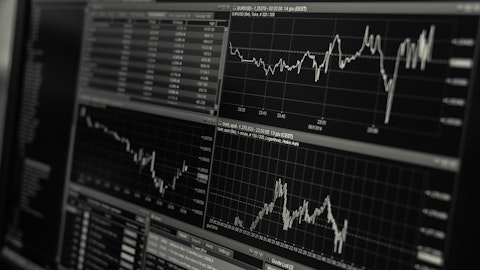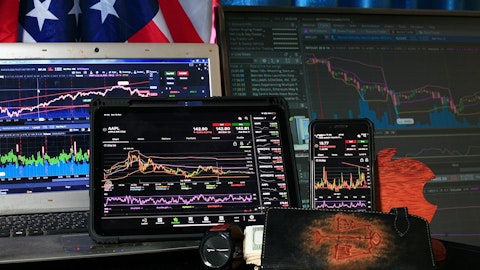Hercules Capital, Inc. (NYSE:HTGC) Q3 2023 Earnings Call Transcript November 2, 2023
Operator: Good day and thank you for standing by. Welcome to the Hercules Capital Q3 2023 Earnings Conference Call. At this time, all participants are in a listen-only mode. After the speakers’ presentation, there will be a question-and-answer session. [Operator Instructions] Please be advised that today’s conference is being recorded. I would now like to introduce your host for today’s call, Michael Hara, Managing Director of Investor Relations. Please go ahead.
Michael Hara: Thank you, Justin. Good afternoon, everyone, and welcome to Hercules conference call for the third quarter 2023. With us on the call today from Hercules are Scott Bluestein, CEO and Chief Investment Officer; and Seth Meyer, CFO. Hercules’ financial results were released just after today’s market close and can be accessed from Hercules Investor Relations section at investor.htgc.com. An archived webcast replay will be available on the Investor Relations webpage for at least 30 days following the call. During this call, we may make forward-looking statements based on our own assumptions and current expectations. These forward-looking statements are not guarantees of future performance and should not be relied upon in making any investment decision.
Actual financial results may differ from the forward-looking statements made during this call for a number of reasons, including, but not limited to the risks identified in our annual report on Form 10-K and other filings that are publicly available on the SEC’s website. Any forward-looking statements made during this call are made only as of today’s date, and Hercules assumes no obligation to update any such statements in the future. And with that, I’ll turn the call over to Scott.
Scott Bluestein: Thank you, Michael, and thank you all for joining the Hercules Capital Q3 2023 earnings call. Our best-in-class venture and growth stage lending platform continued to deliver record earnings and operating performance in Q3 as well as delivering record year-to-date gross fundings of $1.29 billion, which represents an increase of over 17% year-over-year. We were able to achieve record Q3 results despite continued volatility in both the equity and credit markets as well as across the broader global macro landscape. While we are pleased with our continued record operating performance in Q3 and remain optimistic about our positioning in the asset class and our ability to capture further market share over the coming quarters, we continue to take steps to manage our business defensively while maintaining the ability to play offense as the market improves.
This includes enhancing our liquidity position, maintaining very low leverage, tightening our credit screens for new underwritings and driving our first lien exposure up to over 87%, our highest level since Q1 2017. During Q3, we experienced many of the same themes that we have been discussing over the last several quarters with one notable exception capital raising across our portfolio remains strong, exceeding the level of activity that we saw in Q2. Rising rates combined with higher onboarding yields and an increased weighted average portfolio balance drove total investment income, core investment income, and net investment income to record levels. M&A activity and interest continues to be strong across our portfolio and we expect several additional M&A exits over the coming quarters.
Our differentiated business model, which is predicated on asset and liability diversification, fundamental credit underwriting, and longstanding relationships with over a thousand venture capital and private equity investors has continued to serve us well and allows us to outperform in a variety of macro environments. For the remainder of 2023, our focus will remain on prudent underwriting, diversification and maintaining an abundance of liquidity. Let me recap some of the key highlights of our performance for Q3. In Q3, we generated record total investment income of $116.7 million, up over 38% year-over-year, and record net investment income of $76.8 million, up over 53% year-over-year, or $0.52 per share, and providing 130% coverage of our base distribution of $0.40 per share.
This is our fourth consecutive quarter of delivering record net investment income. We also generated return on equity in Q3 of over 20% for the second consecutive quarter. Our portfolio generated a GAAP effective yield of 15.5% in Q3 and a core yield of 14.2%, which is indicative of the recent rate increases and higher onboarding yields for certain new loans. With GAAP leverage at a very conservative 99.8% and continued, robust liquidity across our platform, our balance sheet remains very well positioned. Although we have managed to deliver record year-to-date gross new fundings, we continue to expect the market environment for new deals in our asset class to improve over the coming quarters. Having a strong and diversified balance sheet with maximum liquidity will be a key differentiator for our platform and best positions Hercules to capitalize on the market opportunity that we continue to believe is in front of us.
The focus of our origination efforts in Q3 was once again on diversification with an emphasis on later stage and more scaled opportunities. Our Q3 originations activity was driven by both our technology and life sciences teams delivering healthy funding performance during the quarter, although our new business activity was intentionally weighted more towards the life sciences side. In Q3, approximately 56% of our fundings were to life sciences companies, while approximately 68% of our commitments during the quarter were to life sciences companies. Our unique ability to excel in both technology and life sciences lending, at the same time with dedicated teams in each vertical, helps drive consistent outperformance relative to our peer group. We funded debt capital to 28 different companies in Q3, of which ten were new borrower relationships.
Consistent with what we have seen throughout the year, we expanded our funding relationship with numerous portfolio companies that continue to show strength and achieve performance milestones during the third quarter. In addition, the strong level of funding to existing companies also helped to maintain our available unfunded commitments at $400 million, which was up slightly from $381 million in Q2. Approximately 31% of our available unfunded commitments will expire by the end of the year driving higher expected follow-on fundings through the end of 2023. As we guided to on our Q2 earnings call, our quarterly funding activity in Q3 was backend weighted with over 50% of our quarterly fundings coming in the month of September. This theme is likely to repeat in Q4.
After an atypically strong Q3 for originations, we expect our origination activity in Q4 to moderate slightly, although we remain on track to deliver record annual gross fundings in 2023. Since the close of Q3 and as of October 31, 2023, our deal team has closed $34 million of new commitments and funded $42.7 million. We have pending commitments of an additional $290 million in signed non-binding term sheets. The bar for us on new originations remains very high and we continue to pass on the vast majority of deals that we are currently seeing in the market. We are increasingly hearing from prospective portfolio companies about the importance of partnering with a lender that has a strong balance sheet and staying power, and this gives us great confidence in our ability to continue to generate and deliver quality asset growth over the coming quarters.
Although portfolio company exits and liquidity events for the industry continue to be slow, we are pleased with the activity our portfolio has experienced so far this year. Year-to-date as of today, we have had one portfolio company complete their IPO and two additional portfolio companies which have filed for IPOs along with 13 portfolio companies completing M&A transactions. Our portfolio company enGene Holdings just completed their SPAC merger IPO on November 1. We expect additional M&A transactions for our portfolio companies to close over the coming quarters. Our portfolio activity continues to validate the great work and underwriting that our investment teams do. As we anticipated early loan repayments decreased in Q3 to approximately $148 million, which came in slightly below our guidance of $175 million to $250 million.
For Q4 2023, we expect prepayments to increase from Q3 levels and be in the range of $150 million to $250 million. Although, this could change as we progress in the quarter. Credit quality of the debt investment portfolio remained relatively stable. Our weighted average internal credit rating of 2.28 increased slightly from the 2.24 rating in Q2 and remains within the normal historical range. Our Grade 1 and Grade 2 credits improved to 62.1% compared to 59.4% in Q2. Grade 3 credits were lower at 34.5% in Q3 versus 38.3% in Q2. Our rated 4 credits increased slightly to 2.6% and rated 5 credits increased to 0.8% in Q3 as a result of one loan being downgraded to a 5 during the quarter. Subsequent to quarter-end, one of our rated 4 loans paid off their outstanding obligations to Hercules in full.
In Q3, we added one debt investment on non-accrual. We have two debt investments on non-accrual with an investment cost and fair value of approximately $88.1 million and $24.6 million respectively, or 2.7% and 0.8% as a percentage of the company’s total investment portfolio at cost and value respectively. As of our most recent reporting, 100% of our debt portfolio companies remain current on contractual payments to Hercules. The one new loan added to non-accrual during Q3 was our secured debt investment in Convoy. Our workout efforts remain ongoing and we continue to work with Convoy to maximize our ultimate recovery. We believe that Convoy was a unique situation that resulted from a perfect storm of events that negatively impacted Convoy and its ability to continue operating and raise more equity capital.

At the same time, ongoing and accelerating turmoil and pressure across the broader freight market landscape negated the ability for Convoy to find a strategic buyer for the business as a going concern. Based on our efforts to-date, we currently believe that our net recovery will meet or exceed our Q3 fair value mark and that our recovery efforts will likely wrap up early next year, although, the situation remains ongoing and fluid. With respect to our broader credit book and outlook, we generally remain pleased by what we are seeing on a portfolio level. Our focus on credit underwriting and a diversified asset base is continuing to serve us well. We are seeing general outperformance and positive momentum in terms of capital raising, M&A activity and milestone achievement throughout our life sciences book, while things remain more muted on the technology side with respect to the same.
Public market valuations for growth stage tech and life sciences companies pulled back considerably in Q3, putting additional pressure on fundraising for certain private companies. Despite this and continued increased selectivity and valuation sensitivity from venture capital investors, capital raising across our portfolio remains strong in Q3 with 23 companies raising over $2 billion in new capital in Q3, this was the strongest quarter of new capital raising in our portfolio over the last year and a half. During Q3 2023, Hercules had net realized losses of $2.6 million, comprised of net realized gains of $0.9 million due to the gain on investment funds and debt investments offset by $3.5 million due to the loss on equity and warrant investments.
Through Q3, we have generated $5.6 million of realized gains year-to-date. Our net asset value per share in Q3 was $10.93, a slight decrease of 0.3% from Q2 2023. We ended Q3 with strong liquidity of almost $600 million inclusive of available liquidity and our private funds, we have more than $900 million of liquidity as of the end of Q3. Our balance sheet is strong and stable and it puts us in an advantageous position to be able to benefit from a business environment that we anticipate will get better over the next several quarters. Venture capital ecosystem fundraising and investment activity continued to stay at muted levels relative to the historical highs that we witnessed in 2021 and 2022 with fundraising activity at approximately $43 billion and investment activity at approximately $126 billion for the first three quarters of 2023, respectively according to data gathered by PitchBook-NVCA.
In terms of VC investment activity, Q3 was equal to Q2 with $40 billion of new investments. Year-to-date, Q3 2023 investment levels have already exceeded 2019’s $103 billion, and the number of investment deals is more than double the number in 2019, 9,962 deals versus 4,431 deals. We expect fundraising to stay at much lower levels than prior years and investment activity to remain stable as we approach the end of the year. With our record operating performance year-to-date, we exited Q3 with increased undistributed earnings spillover of over $155 million or $1.03 per ending shares outstanding. For Q3 maintained our base distribution of $0.40 and declared a supplemental distribution of $0.08 for a total of $0.48 of shareholder distributions.
In closing, our scale institutionalized lending platform and our ability to capitalize on a rapidly changing competitive and macro environment continues to drive our business forward and our operating performance to record levels. In Q3, Hercules delivered its second consecutive quarter of over $100 million of quarterly core income, which excludes the benefit of prepayment fees or fee accelerations from early repayments. Our success is attributable to the tremendous dedication, efforts, and capabilities of our 100 plus employees and the trust that our venture capital and private equity partners place with us every day. We are thankful to the many companies, management teams, and investors that continue to make Hercules their partner of choice.
I also want to acknowledge the handful of portfolio companies that we have and certain of our VC partners and investors that are being impacted by the terrorist attack that took place on October 7 and the events that have followed. I will now turn the call over to Seth.
Seth Meyer: Thank you, Scott, and good afternoon ladies and gentlemen. Q3 marked another quarter of records for Hercules Capital. Total investment income was a record of $117 million. We had record net investment income of $77 million and core income of $0.46 per share. To support the $195 million of portfolio growth, we proactively strengthened our balance sheet and liquidity position with the equity offering in August. We also received a green light letter from the SBA for an additional SBIC license, which upon final licensing will provide us with additional attractive financing. With these points in mind, let’s review the following areas, the income statement performance and highlights, NAV, unrealized and realized activity, leverage and liquidity, and finally, the financial outlook.
Turning first to the income statement performance and highlights. Total investment income exceeded $100 million, again at $116.7 million, driven by the year-to-date growth in the debt portfolio on consistent business underwriting and a small increase in benchmark rates. Core investment income a non-GAAP measure, again exceeded a $100 million at $107.4 million. Core investment income excludes the benefits of income recognized as a result of loan prepayments. Net investment income was another record of $76.8 million, a 1.4% quarter-over-quarter increase, or $0.52 per share in Q3. NII margin was 65.8% for Q3 and has increased every quarter since Q1 2022. Our effective in core yields in the third quarter were 15.5% and 14.2% respectively compared to 16% and 14.1% in the prior quarter.
The decrease in the effective yield was due to lower prepayments consistent with our guidance versus the prior quarter. The increase in the core yield was due to an increase in coupon interest as a result of benchmark interest rates. We continue to forecast a leveling of core yield hereafter due to minimal movement from the Fed in the coming quarters. Turning to expenses, our gross operating expenses for the quarter decreased slightly to $42.4 million compared to $42.9 million in the prior quarter. Net of costs recharged to the RIA, our net operating expenses were fairly level at $40 million. Interest expense and fees decreased modestly to $19 million from $19.6 million in the prior quarter due to lower utilization of the credit facilities as a result of the equity offering in early August.
SG&A expenses remained stable at $23.4 million in line with my guidance of $23 million to $24 million. Net of cost recharged to the RIA, the SG&A expenses were at $21 million. Our weighted average cost of debt remains stable at 4.8% based on the lower utilization of the credit facilities due to the equity raise. Our ROAE or NII over average equity increased modestly to 20.2% for the third quarter and our ROAA or NII over average total assets was 9.7%. Switching to NAV unrealized and realized activity. During the quarter, our NAV decreased slightly by $0.03 per share to $10.93 per share. This represented an NAV per share decrease of 0.3% quarter-over-quarter. The main drivers for the decrease were the net change in the unrealized depreciation of $46.2 million, including the reversal of prior unrealized appreciation of $4.5 million, mainly due to investment disposals or write-off partially offset by accretion due to the equity sale in August.
Our $46.2 million of unrealized depreciation was primarily driven by $30.4 million of net unrealized depreciation on the loan portfolio and $9.9 million of depreciation to the public equity and warrant portfolio. Moving on to leverage and liquidity. Our GAAP in regulatory leverage decreased to 99.8% and 89.2%, respectively compared to the prior quarter due to the equity raise in August. Netting out leverage with cash on the balance sheet, our net GAAP in regulatory leverage was 97.9% and 87.3%, respectively. We ended the quarter with approximately $600 million of available liquidity. As a reminder, this excludes the capital raised by the funds managed by our wholly-owned RAA subsidiary. Inclusive of these amounts the Hercules platform had more than $900 million in available liquidity.
The strong liquidity positions us very well to support our existing portfolio companies and source new opportunities. We continue to have no material near-term maturities giving us the ability to be opportunistic, should we decide to raise additional capital to support the business. Finally, on the outlook points. We expect our core yield range to tighten at 13.8% to 14%. As a reminder, approximately 95% of our debt portfolio is floating with a floor, so any additional rate heights will benefit our core yield going forward. Although, very difficult to predict as communicated by Scott, we expect our $150 million to $250 million in prepayment activity in the fourth quarter. We expect our fourth quarter interest expense to increase compared to the prior quarter based on portfolio growth expectations.
For the fourth quarter, we expect SG&A expenses of $21 million to $22 million and RIA expense allocation of approximately $2 million. As previously guided, we expect the advisor business to begin paying dividends in the fourth quarter to Hercules Capital. Initially, the dividend should be approximately $1 million per quarter with variation depending on the portfolio growth and performance. In closing, our balance sheet remains strong to support our existing portfolio as well as opportunistically invest in the best opportunities. I’ll now turn the call over to the operator to begin the Q&A part of our call. Justin, over to you.
See also 15 Worst Performing Disney Animated Movies of All Time and Ken Fisher’s Top 15 Healthcare Stock Picks.
Q&A Session
Follow Hercules Capital Inc. (NYSE:HTGC)
Follow Hercules Capital Inc. (NYSE:HTGC)
Operator: And thank you. [Operator Instructions] And our first question comes from Crispin Love from Piper Sandler. Your line is now open.
Crispin Love: Thanks. Good afternoon everyone. Scott, you’ve made some comments on being weighted more towards life sciences in the quarter. Just curious if you can dig a little deeper there. Was that due to credit expectations, demand from borrowers or just anything else worth calling out and would you expect to be more weighted towards life sciences over the near term?
Scott Bluestein: Sure. Thanks, Crispin. So it was an intentional move. I think we’re one of the few private credit direct lenders in the market that have the ability to sort of toggle back and forth between technology lending and life sciences lending. And as we’ve said consistently over the course of the years, depending on what our macro assessment is, we will go back and forth in terms of waiting between those two sectors on a quarterly basis. Over the course of Q3, and we would expect this to sort of remain this way in Q4 as well, given the macro volatility that we’re seeing, given some of the turmoil that we’re seeing on kind of a global perspective our view was that the life sciences sector represented a better credit opportunity for us in terms of short-term underwritings, and that was our focus in Q.
We expect that to continue to be our focus in Q4. I want to emphasize however, that we will continue to very actively pursue both technology and life sciences transactions. I mentioned the numbers in my prepared remarks, but it was not a 100% life science, and 0% technology. It was essentially a 60/40 allocation in the quarter, and we think we’ll be pretty consistent for the remainder of the year in terms of those numbers.
Crispin Love: Okay, great, Scott, that’s helpful. And then just, just on leverage here did remains very well contained. But looking a little further out, can you talk about where you’d be willing to increase leverage to if opportunities pick up just from the changing competitive landscape out there, and I’m thinking over say the next several quarters to a year if the environment improves?
Scott Bluestein: Sure. Thanks, Crispin. So, we, our guidance has always been a 125 [ph] GAAP leverage ceiling, and we’re going to stay a fair distance away from that just for mark-to-market volatility at the end of quarters and things of that nature. While we are working through a leading up to a recessionary environment, we’re going to be pretty careful and stay around a 1.1 level. We have taken it up in 2022, and at certain quarters to about the 1.15 level historically twice. So, I would see that as our ceiling, but I would see us operating in the 1.1 to 1.10 range in the foreseeable future as a result of the recessionary environment and wanting to maintain sufficient liquidity.
Seth Meyer: And Crispin, I would just add to that from a positioning perspective right now we think two critical items from a platform perspective are high liquidity and low leverage, and the reason for that is really not credit related. Its new business related based on the conversations that our investment teams are having with venture capital firms, private equity firms and prospective companies. We are actually very optimistic about what the new business environment will look like, particularly in the first half of next year. And we think being able to aggressively move to win those opportunities will be a key point of differentiation. And by maximizing liquidity and keeping leverage low, we’ll be able to react very quickly to take advantage of that market opportunity when the time arises.
Crispin Love: All right. I appreciate you taking my questions.
Seth Meyer: Thanks Crispin.
Operator: And thank you. And one moment for our next question. And our next question comes from Christopher Nolan from Ladenburg Thalmann. Your line is now open.
Christopher Nolan: Hey guys. Seth, based on your effective yield – core yield guidance, should we assume that the flow through of the rate increases is just about done?




